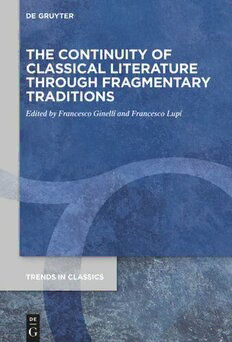
The Continuity of Classical Literature Through Fragmentary Traditions PDF
Preview The Continuity of Classical Literature Through Fragmentary Traditions
The Continuity of Classical Literature through Fragmentary Traditions Trends in Classics – Supplementary Volumes Edited by Franco Montanari and Antonios Rengakos Associate Editors Stavros Frangoulidis · Fausto Montana · Lara Pagani Serena Perrone · Evina Sistakou · Christos Tsagalis Scientific Committee Alberto Bernabé · Margarethe Billerbeck Claude Calame · Jonas Grethlein · Philip R. Hardie Stephen J. Harrison · Stephen Hinds · Richard Hunter Christina Kraus · Giuseppe Mastromarco Gregory Nagy · Theodore D. Papanghelis Giusto Picone · Tim Whitmarsh Bernhard Zimmermann Volume 105 The Continuity of Classical Literature through Fragmentary Traditions Edited by Francesco Ginelli and Francesco Lupi ISBN 978-3-11-070037-4 e-ISBN (PDF) 978-3-11-071222-3 e-ISBN (EPUB) 978-3-11-071229-2 ISSN 1868-4785 Library of Congress Control Number: 2020950007 Bibliographic information published by the Deutsche Nationalbibliothek The Deutsche Nationalbibliothek lists this publication in the Deutsche Nationalbibliografie; detailed bibliographic data are available on the Internet at http://dnb.dnb.de. © 2021 Walter de Gruyter GmbH, Berlin/Boston Editorial Office: Alessia Ferreccio and Katerina Zianna Logo: Christopher Schneider, Laufen Printing and binding: CPI books GmbH, Leck www.degruyter.com Preface The chapters collected in this volume originate from papers that were originally presented at the panel ‘From Sources to Editions and back again. The Continuity of Classical Literature through Fragmentary Traditionsʼ. The panel was part of the 10th Celtic Conference in Classics (19‒22 July 2017, McGill University and Univer- sité de Montréal) and saw a total of fifteen papers delivered over three days. In sending this book to the press, we would like to express our gratitude to the organisers of the Montreal Conference, Elsa Bouchard (Université de Mont- réal) and William Gladhill (McGill University), who gave us the opportunity to set up our panel and wonderfully hosted us at both universities. We are also grateful to all the colleagues who attended the panel and contributed to it, either by pre- senting a paper or by joining the fruitful discussions that followed each presen- tation. We believe that the panel proved a success in promoting the academic cross-fertilisation policy that drives the Celtic Conference in Classics and wish to acknowledge the collaborative and friendly spirit that we experienced in Mon- treal. Gratitude is also due to Raymond L. Capra, Eva Falaschi, Patrick J. Finglass, Kyriaki Ioannidou, Chiara Monaco, Enrico Emanuele Prodi, and Effie Zagari. We are very grateful to Suzanne Sharland, for her thorough linguistic revision of the entire volume and for further valuable comments and suggestions on its con- tents. We also wish to credit the Yale Papyrus Collection, Beinecke Rare Book and Manuscript Library, as the source of the images reproduced in Giulio Iovine’s chapter (8), and express our gratitude to Ellen Doon, the Library’s Head of the Manuscript Unit. We also wish to thank Serena Pirrotta, Marco Acquafredda, and Anne Hiller for their interest in the project and thorough assistance throughout the editorial process; Katerina Zianna did a wonderful job in preparing the man- uscript for publication and taking care of its editing. Lastly, we would like to acknowledge the support provided by the Depart- ment of Cultures and Civilizations of the University of Verona. Francesco Ginelli Francesco Lupi https://doi.org/10.1515/9783110712223-202 Contents Preface V List of Figures IX List of Tables XI Francesco Ginelli and Francesco Lupi Introduction 1 Stefano Vecchiato Marginalia to Hesiodic Fragments: A Possible Dis-attribution (Fr. 41 M.–W.), a Possible Attribution (Fr. 327 M.–W.), and Some Recently (Re-)discovered Fragments 19 Francesco Lupi To Belong or not to Belong: A Few Remarks on the Lyric Fragments of Sophocles’ Tereus 37 Chiara Meccariello ‘Well Begun is Half Done’? Uses and Misuses of Incipits in Greek Antiquity and Beyond 57 Roberta Berardi Collecting Fragments for a Fragmentary Literary Genre: The Case of Greek Hellenistic Oratory 79 Francesco Ginelli The New Nepos: Prolegomena Toward a Renumbering of Cornelius Nepos’ Fragments 103 Jarrett T. Welsh The Fifth Glossary of Nonius Marcellus 121 Nereida Villagra Mythographus Homericus, Ἱστορίαι and Fragmentary Mythographers: A Case Study on Phineus and the Argonauts 145 VIII Contents Giulio Iovine The Unruly Fragments: Old Problems and New Perspectives in Latin Military Papyri from Dura-Europos (P. Dura 56, 64, 72, 74, 76, 89, 113) 165 List of Contributors 193 Index of Names 195 Index Locorum 205 List of Figures Fig. 1: P. Dura 56: Docket in fr. A, above l. 1. 169 Fig. 2: P. Dura 71: Docket in the upper margin. 170 Fig. 3: P. Dura 66 f: Docket in the upper margin. 170 Fig. 4: P. Dura 63: Docket in the upper margin. 170 Fig. 5: Fr. A. 172 Fig. 6: Fr. B. 173 Fig. 7: Fr. C. 173 Fig. 8: Fr. B with smaller scraps. 174 Fig. 9: Fr. h (m in Marichal’s edition). 174 Fig. 10a: Current status: ] ḳal ̣ [ . 175 Fig. 10b: Marichal’s edition (upside down): e]x̣ Kạl[ . 175 Fig. 11: Letter A: The smaller scraps. 176 Fig. 12: Letter B: The smaller scrap. 176 Fig. 13: Letter A, verso: The addressee’s name. 177 Fig. 14: P. Dura 72. 179 Fig. 15: P. Dura 72: ạṇ[, or ṃạ[? 180 Fig. 16: P. Dura 74: -anae, not -ante. 181 Fig. 17: P. Dura 76: Similar damages. 184 Fig. 18: P. Dura 74: A possible subscription. 185 Fig. 19: P. Dura 89 (= DP 9 recto), col. II, ll. 5–6 (the scrap provides coh and traces of the figure XX, directly to be linked to Pal of Palmyrenorum). 187 Fig. 20: P. Dura 107 (= DP 9 verso), col. II, l. 12. 187 Fig. 21: The papyrus in its current position. 190 Fig. 22: The papyrus turned 180°. 190 https://doi.org/10.1515/9783110712223-204
